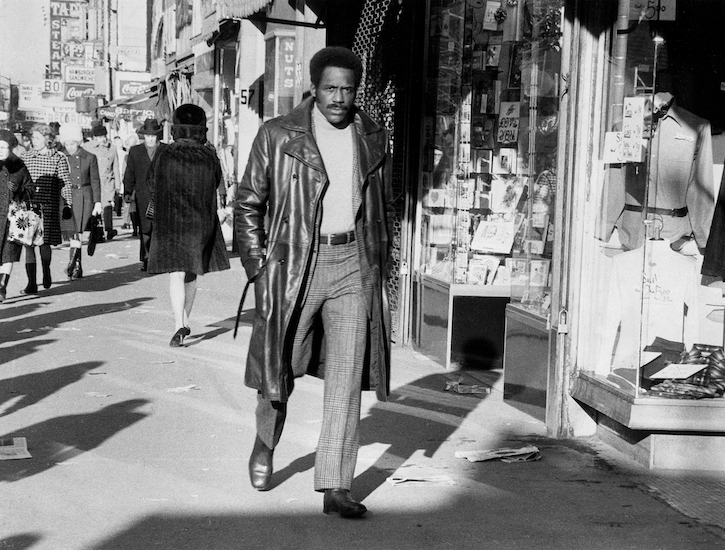
It’s a funny thing about the men’s turtleneck.
Most male garments which were born from the world of the working class, the military, and/or sports, and then became the clothing choice of rebels in the mid-20th century, still retain a bit of their aura of ruggedness and edge today, even though they can be more than a century removed from their origins and have become thoroughly mainstream. Witness the fact that jeans, leather jackets, and t-shirts, which were first worn by miners, aviators, and GIs before becoming the duds of rebel-without-a-cause types during the 1950’s, still evince a little coolness even now.
Yet the turtleneck, which has the same sort of manly history, typically does not.
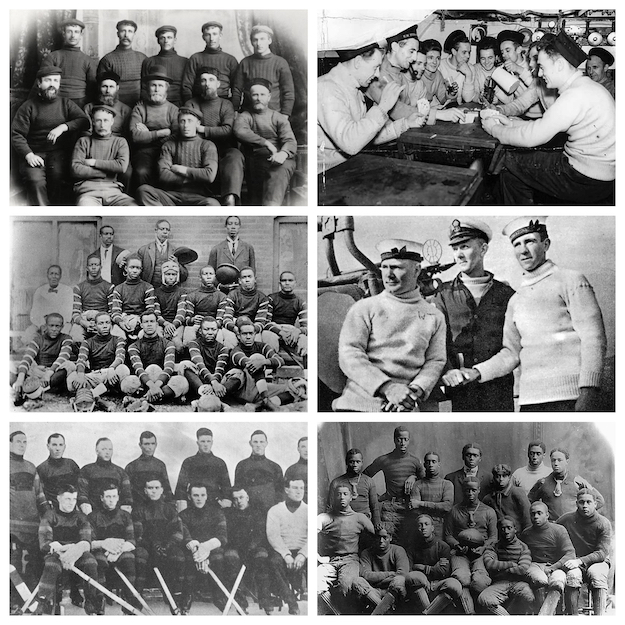
Turtlenecks as we know them today were worn by working class men starting in the latter half of the 19th century. They were particularly popular amongst dockworkers, fishermen, and sailors, for the garment’s signature high-reaching, folded-over collar served a valuable functional purpose in insulating the neck from cold winds and keeping the men warm as they labored. Turtlenecks were worn by athletes of the time — whether they played baseball, football, polo, or hockey — for the very same reason.
The garment really came into style in the 1950’s, for the most countercultural of reasons. They were adopted as a stylish alternative to wearing a dress shirt and tie, and thus worn by those most inclined to chafe at anything either literally or metaphorically buttoned-up: artists, musicians, poets, philosophers, intellectuals. Beatniks.
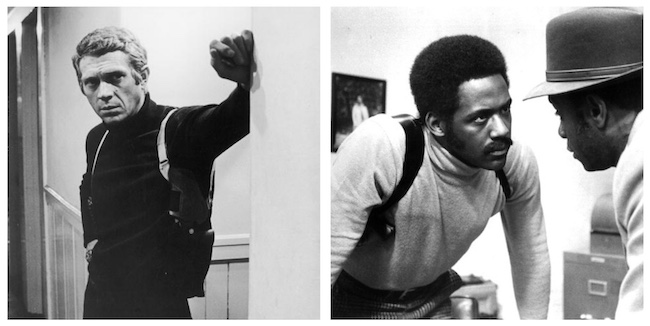
The turtleneck’s popularity and association with culture’s edgier, more renegade-esque types continued into the 1960’s, being adopted by members of the Black Panthers, and becoming the notable sartorial choice of cinematic detectives from Steve McQueen’s Frank Bullitt to Richard Roundtree’s John Shaft.
Yet despite this iconoclastic history, today the turtleneck is often thought of as kind of dweeby — a little twee, stodgy, effete. Why is that?
Well, one can only surmise the exact cultural currents that moved the turtleneck from rugged to hip to nerdy, but it likely can be traced back to its prevalence on college campuses and amongst the beatnik scene. Once-rebellious intellectuals became aging professorial yuppies. Their personal lifestyles moved closer to the mainstream of culture, while the mainstream of culture moved closer to what was formerly considered rebellious (eschewing dress shirts and ties isn’t so edgy anymore). Thus turtlenecks maintained a kind of nerdy reputation befitting its ties to academia, while academia lost some of its cool cache.
A hypothesis at least.
At any rate, the popularity and connotations of the male turtleneck have waxed and waned over the last half century, and today reached a status that seems to be approaching something like neutrality.
In an effort to further tip the dial of the turtleneck into neutral territory, and turn an underutilized part of the male wardrobe into something more guys can reach for without hesitation, below we share how to pick a turtleneck and wear it with style.
Picking a Turtleneck
The turtleneck can be a handsome, functional, and versatile garment. Donning one can dress up a pair of jeans, or dress down a suit. Soft and stretchy, turtlenecks are more comfortable than dress shirts, and yet still make you look put-together. They can read a little formal, but with a style that isn’t buttoned-up. As such, they’re a good look for the man who wants to come off as suave but unstuffy.
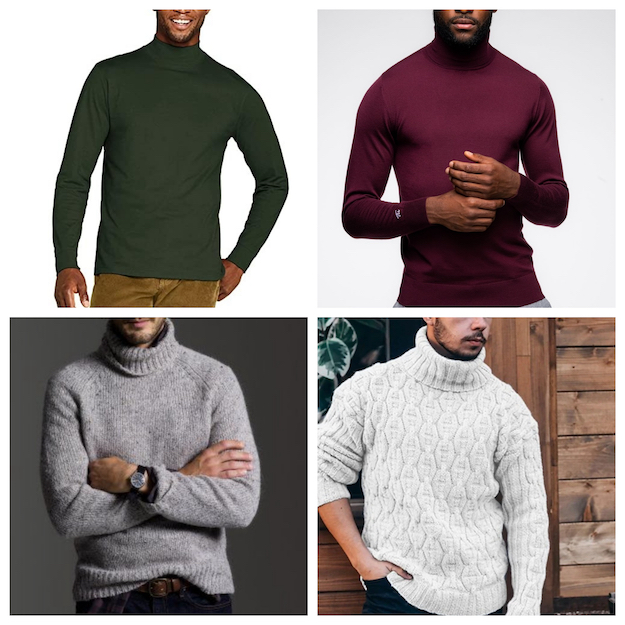
Thinner/fitted turtlenecks (top) vs. thicker/looser turtlenecks (bottom).
The two types of turtlenecks. Turtleneck types can roughly be broken down into two main categories:
- Thinner/fitted. A thinner style turtleneck looks a little more formal and can be layered under suit and sport jackets. Generally more stylish overall.
- Chunky/looser. Typically too thick to be layered under jackets, the chunky turtleneck is a stand-alone piece. They evince a more casual look and are appropriate for pairing with jeans.
Broken down by body type. If/how you should wear the two above types of turtlenecks depends on your body type:
- If you have a fit-to-average physique: Wear a thin/fitted turtleneck alone, or layer under a jacket. A chunkier turtleneck worn by itself will also look fine.
- If you’re overweight: Avoid wearing thin/fitted turtlenecks by themselves, as the clingy material will highlight every bulge and imperfection of your torso/paunch. You can still wear a fitted turtleneck, but layer it under a jacket. You should likewise avoid wearing a chunky turtleneck by itself; while it won’t be quite as unforgiving as a thin/fitted one, it will just make your girth seem girth-ier and your body appear more rotund. Do also keep in mind that if you carry a fair amount of weight in your face, you may wish to avoid all turtlenecks, as the collar draws attention upwards and will frame and highlight a double-chin.
- If you’re skinny: Wearing a thin/fitted turtleneck alone will make you appear skinnier, so layer it with a jacket to fill out your figure. The texture and thickness of a chunky turtleneck will be a plus for you, as it will add some heft to your physique.
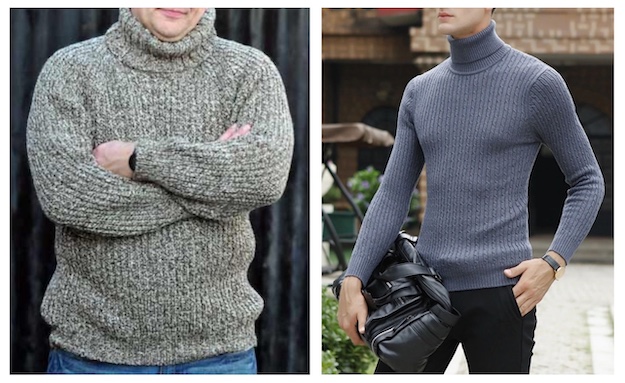
Examples of how a thick sweater on a bigger man, and a thin sweater on a skinnier man, can prove unflattering, making the big man look bigger and the skinnier man look skinnier. Both body types benefit from layering the turtleneck under a jacket.
Wearing & washing. Because of the fitted nature of thinner, slimmer turtlenecks, it is not recommended that you wear an undershirt underneath them, as the outline of the undershirt will show through. Since you will be wearing the turtleneck close to your body, and it will absorb your bodily sweat/grime, it will need to be laundered more often, so look for ones that are machine washable. One made with merino wool will be warm, comfortable, and relatively easy to care for. You can of course wash more delicately made turtlenecks by hand, but that’s naturally a bit of a pain.
If you’re wearing a white thin/fitted turtleneck without an undershirt, check to see if your skin/nipples show through; if they do, layer a jacket over it.
4 Ways to Wear a Turtleneck
Turtleneck as classic style icon.
Below you’ll find 4 ways to wear a turtleneck with style. There are of course many more, but these are some pretty easy-to-pull-off, can’t-miss looks to try.
Look #1: Navy Turtleneck + Gray Suit
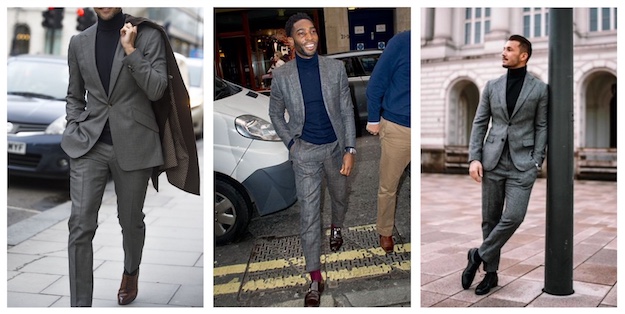
A turtleneck makes a great substitute for a dress shirt under a suit, making for a look that’s less buttoned-up and business-y, while still formal and put-together. The collar of a turtleneck works just as the collar of a dress shirt does in filling in the space between the jacket’s lapels and framing the face, so that it avoids the incongruous contrast one gets from wearing a t-shirt under a suit jacket. A navy turtleneck with a gray suit is a perfect pairing. A black turtleneck also works great here.
Look #2: Black Turtleneck + Gray Trousers
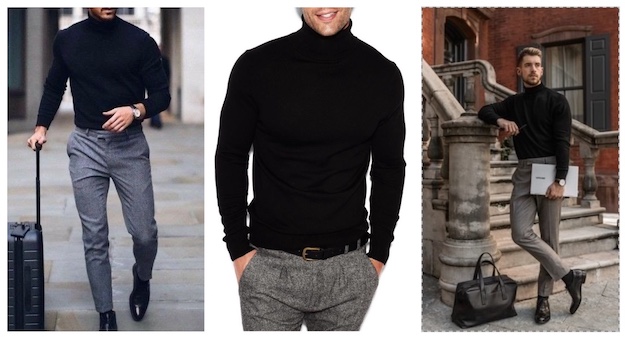
The black turtleneck is widely flattering, and while it’s not so iconoclastic anymore, it still maintains a little avant-garde panache. A stand-alone black turtleneck looks great with a pair of gray wool trousers; it’s a simple yet handsome look that’s ready for any nice event.
Look #3: Cream Turtleneck + Navy Sport Jacket/Blazer
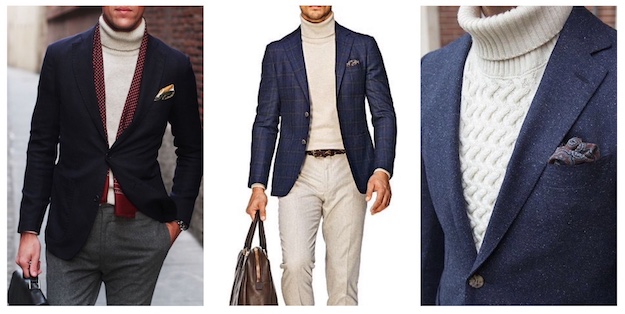
Cream (as opposed to white, which can look too stark) is a great turtleneck color. A textured cream turtleneck that’s a little thicker (but can still be layered) looks especially good when worn under a navy blazer or sport coat. The look’s got a nice nautical vibe to it. With darker pants and a heavier jacket, it’s a get-up you can wear in the winter; with chinos and a lighter-weight jacket, it’s a combo you can bust out on cool spring days.
Look #4: Black Turtleneck + Denim Jacket
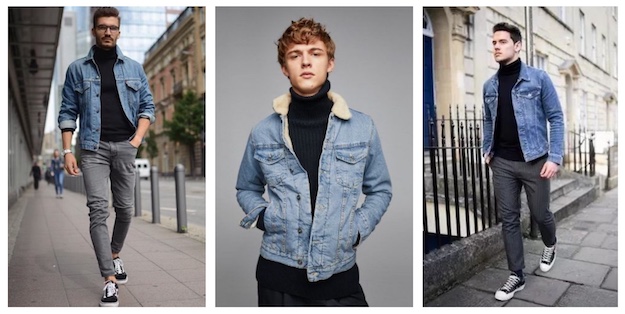
To exorcise any remaining vestiges of fuddy-duddy-ness from the turtleneck, pair a black one with a denim jacket. It’s a look that reveals the rugged coolness that’s been part of the turtleneck’s DNA all along.
The post How to Wear a Turtleneck (Without Looking Like a Dweeb) appeared first on The Art of Manliness.
0 Commentaires